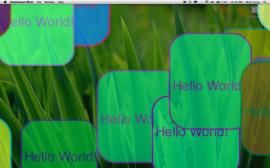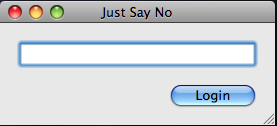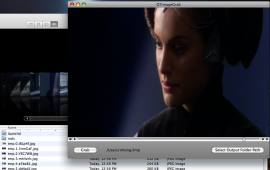Git and .mac: A Match Made In Purgatory
Last year, I made the switch from subversion to Git. After 9+ months of using Git, I can comfortably say that it was a very good choice. While branching is easy in subversion, merging is just as bad as it was in cvs. Git is a significant improvement over that. In addition, since Git is a true distributed source control system, I can easily do branches and merges on my local machine without an internet connection and just “push” my changes to my off-site server when it is convenient.
I am also a user of .mac. I like the service and the iDisk is probably my favorite feature. Therefore, I wondered, like chocolate and peanut butter, could I put these two together and come up with something better than the individual parts?
(more…)
Core Animation Tutorial: Dashboard Effect
 In our continued efforts to demonstrate different ways to use Core Animation, we have noticed different effects you see in OS X itself that present an interesting challenge to duplicate. In a previous post, we demonstrated how to shake a login window similar to the way that OS X shakes the login window when the user enters the wrong password. This time, we’re going to demonstrate how to do what we’ve dubbed the Dashboard Effect.
In our continued efforts to demonstrate different ways to use Core Animation, we have noticed different effects you see in OS X itself that present an interesting challenge to duplicate. In a previous post, we demonstrated how to shake a login window similar to the way that OS X shakes the login window when the user enters the wrong password. This time, we’re going to demonstrate how to do what we’ve dubbed the Dashboard Effect.
I’m not sure this is the best name for it as some people may think we mean the ripple effect you see when you drop a new Dashboard widget on the screen, but what we mean is the way in which the Dashboard widgets that are already employed in Dashboard fly in and out of view when you enable and disable Dashboard. Enable Dashboard now and watch your widgets fly in from offscreen. Then disable it and watch the widgets fly out again. This is what we mean by the Dashboard effect and this is what we set out to duplicate.
(more…)
MacBook Air: Thoughts and Issues
For those of you who only read this blog for coding suggestions and tutorials — please hit next on your feed reader :)
For those who are also interested in our development environments, hardware, etc. then please read on.
(more…)
Cocoa Tutorial: How to Crash Cocoa
This article is designed to serve multiple purposes. First, it is to educate which I hope that it will. Secondly, it is a personal memory so that if (when!) I run into this issue again, I will be able to use Google to find this post and remember why I am an idiot and why the default settings for things are not always the best settings.
First as always, here is the project that goes with this article.
If you run this application you will see that it does basically nothing. The interesting part of this app is how it crashes. To crash this application, perform the following steps:
- Open the application.
- Select the Application menu.
- Select the About window.
- Close the About window.
- Open the Application menu again.
iWeb Buddy has been released!
 iWeb Buddy has gone Gold Master!
iWeb Buddy has gone Gold Master!
Marcus S. Zarra of Zarra Studios, released iWeb Buddy on March 6, 2007.
Do you like using iWeb but wished it had some advanced feature that you simply need for your website? Perhaps you want Google Analytics on your site or you want to add Social Bookmarks to your blog posts? Perhaps you just want to have more than one Domain file.
iWeb Buddy solves all of these issues for you! With iWeb Buddy you can “process” the pages generated by iWeb and add those pieces of html code or javascript that you need to make your site complete.
iWeb Buddy has the following features:
- Multiple Domain files that open properly in iWeb.
- Google Analytics injection.
- Social Bookmarks (Digg, Slashdot, etc.)
- Haloscan comments injection.
- Mint site tracking.
- RSS Feed redirection (for use with FeedBurner, etc.)
- RSS Feed linking on blog entries.
- Custom HTML body code
- Custom HTML header code
- And a lot more…
To find out more information about this new product, visit its product page.
(more…)
Core Animation Tutorial: QTMovieLayer and Image Animation
 In my first post I wrote about using NSOperation to grab an image of the current frame of a QuickTime movie while it was playing and save it out to the filesystem. Considering the excitement that is surrounding Core Animation these days, I thought it might be interesting to take that project and change it to instead grab the current frame and animate it across the screen using a Core Animation layer (CALayer). I had to employ a few tricks to get it to work, but the end result, while completely useless, is quite excellent.
In my first post I wrote about using NSOperation to grab an image of the current frame of a QuickTime movie while it was playing and save it out to the filesystem. Considering the excitement that is surrounding Core Animation these days, I thought it might be interesting to take that project and change it to instead grab the current frame and animate it across the screen using a Core Animation layer (CALayer). I had to employ a few tricks to get it to work, but the end result, while completely useless, is quite excellent.
MacDevNet Podcast: MDR005 Data
I had the pleasure recently of being on an episode of the Mac Developer’s Roundtable with Kevin Hoctor, Aaron Hillegas and Steve “Scotty” Scott. In this latest episode, Scotty introduced the topic of data, how to store it, access it, etc. To kick it off, Aaron delivered a fantastic history of Core Data or as it was originally called, Enterprise Objects.
I highly recommend this episode to anyone who is interested in Core Data and Cocoa in general.
You can get the episode from MacDevNet.com.
Core Animation Tutorial: Wizard Dialog with Transitions
A question that I have seen pop up a few times is how to build a Wizard in Cocoa. Having thought about that question a bit I realized that a better answer to it is — how to build a wizard in Cocoa using Core Animation.
The basic concept behind this project is to present a window to the user that will walk them through a list of options. To accomplish this task, I created a number of NSViews that will be presented to the user in order so that they can make the decisions needed. To make this a little easier, I have extended NSView to create MSZLinkedView. The added functionality in this subclass is that the view has a reference to the previous and next views in the wizard. These references are set in interface builder directly so that I do not have to worry about them in code.
Does Objective-C Perform Autoboxing on Primitives?
This article is inaccurate.
The writer was smoking crack or something when he wrote it and has not been able to duplicate his tests since. This article is left here for historical reasons.
One of the things about Objective-C that I find extremely useful is the ability to resolve a method call at runtime. In addition this same functionality allows us to do some fairly creative things with callbacks, passing messages between threads, etc.
However there is a bit of a trick when it comes to passing primitives though some of these methods. For example, one method that I use quite frequently is performSelectorOnMainThread:withObject:waitUntilDone:. How exactly does one pass a BOOL or an int to this method?
(more…)
Core Animation Tutorial: Window Shake Effect
Core Animation is really the buzz among Cocoa developers these days and we are no different from the rest. Learning to do simple fades and frame movement is trivial, but figuring out the more complex effects is quite a challenge. We decided to venture out and try to create some really concise examples of effects you might find used in Leopard. And while these effects may not be done with Core Animation where they are found in the OS, we’ve set out to duplicate them in Core Animation regardless. Our first challenge? Shaking a login window.

NSOperation Example
 Forget Mandelbrot sets (Apple coding headstarts) and Expression Trees. NSOperation is really not that hard.
Forget Mandelbrot sets (Apple coding headstarts) and Expression Trees. NSOperation is really not that hard.
In his post, Marcus introduced how to use NSOperation to greatly simplify multi-threading tasks in your application. I am now going to provide a step-by-step walk-through sample application that uses NSOperation, NSOperationQueue, and QTKit.
While looking around the Internet, I noticed that the only examples of using NSOperation available were related to scientific applications. I wanted something that I could relate to a little better and since I’ve been working with QTKit a lot lately, I figured it would be a good framework to build from. This application simply grabs images of a movie while it is playing back and saves them out to a file. It’s pretty simple, but it shows how to do something fairly practical.
(more…)
Cocoa Coding Practice: Old School vs New

This post is in response to a few queries that I have received regarding my last post showing an NSOperation example. One of the questions raised that I will focus on is my -(void)dealloc method in the NSOperation subclass. The questions boiled down to:
Why are you using releases at all. Garbage collection is the future!
and
You should be just doing [self setVar:nil] instead of that [var release], var = nil; crap.
Cocoa Tutorial: NSOperation and NSOperationQueue
 Threading is hard in any language. And what is worse, when it goes wrong, it usually goes wrong in a very bad way. Because of this, programmers either avoid threading completely (and refer to it as the spawn of the devil) or spend a LOT of time making sure that everything is perfect.
Threading is hard in any language. And what is worse, when it goes wrong, it usually goes wrong in a very bad way. Because of this, programmers either avoid threading completely (and refer to it as the spawn of the devil) or spend a LOT of time making sure that everything is perfect.
Fortunately, Apple has made a lot of progress in OS X 10.5 Leopard. NSThread itself has received a number of very useful new methods that make threading easier. In addition, they have introduced two new objects: NSOperation and NSOperationQueue.
(more…)
